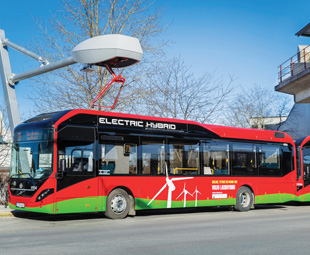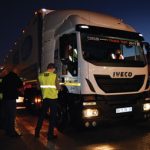Volvo electric hybrids clean up Stockholm

FRANK BEETON reports on important on-the-job testing being undertaken by Volvo.
Regular readers will be well aware of our often-stated opinion that the public transport environment is the ideal place to apply alternative driveline technology. Buses, trams and light railways work on fixed routes, usually through urban or well-populated areas, where technical support of the vehicles and regular monitoring of the advancing technology is relatively easy to accomplish and any emerging snags can be swiftly dealt with.
Try doing that with trucks or coaches running off to distant destinations every other day or week!
Inevitably, much of the new technology is first put to work in locations close to the manufacturers’ home base. Volvo, for instance, is testing the inductive charging technique – probably the most advanced form of battery replenishment yet proposed – in its home town of Gothenburg, Sweden, for exactly the reasons mentioned.
However, once any new technology direction has been proved to be viable, it needs to be applied farther afield, to establish and grow consumer confidence. This imperative makes the recent news that the public transport authority in Stockholm has commenced in-service operations with eight Volvo electric hybrids, on its route 73, very meaningful.
Route 73 is slightly more than eight kilometres in length, which is significant. The operating range of Volvo’s 7900 Electric Hybrid on lithium battery power alone is seven kilometres, which means that these vehicles need to use their on-board diesel engines on every trip. This makes it a “real world” operational situation, and not one tailored to suit the limitations of the available technology.
To minimise emissions, these engines are fuelled with biodiesel, and when the buses reach the termini at each end of the route, they use their roof-mounted collectors to connect with Siemens 300 kW overhead power rails for a six- to ten-minute battery recharge.
So, during the course of each trip, the vehicle will fully exhaust its batteries, bring in its on-board engine to complete the task, and deploy its charging equipment, providing a thorough test of all these systems.
This project is part of the Zero Emission Urban Bus System programme that is co-financed by the European Union, and is to be supported by Volvo, electricity authority Vattenfall, Siemens and several other partners over two years. After this, the buses, which are now the only vehicles operating this particular service, will be expected to continue as part of regular operations.
Route 73 runs through central Stockholm from Ropsten to Tomteboda/Karolinska, so the emission-free and quiet (65 dB) operation of these vehicles under battery power should be greatly appreciated.
Published by
Focus on Transport
focusmagsa




